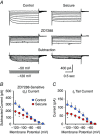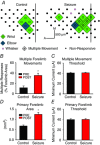HCN channels segregate stimulation-evoked movement responses in neocortex and allow for coordinated forelimb movements in rodents
- PMID: 27568501
- PMCID: PMC5199725
- DOI: 10.1113/JP273068
HCN channels segregate stimulation-evoked movement responses in neocortex and allow for coordinated forelimb movements in rodents
Abstract
Key points: The present study tested whether HCN channels contribute to the organization of motor cortex and to skilled motor behaviour during a forelimb reaching task. Experimental reductions in HCN channel signalling increase the representation of complex multiple forelimb movements in motor cortex as assessed by intracortical microstimulation. Global HCN1KO mice exhibit reduced reaching accuracy and atypical movements during a single-pellet reaching task relative to wild-type controls. Acute pharmacological inhibition of HCN channels in forelimb motor cortex decreases reaching accuracy and increases atypical movements during forelimb reaching.
Abstract: The mechanisms by which distinct movements of a forelimb are generated from the same area of motor cortex have remained elusive. Here we examined a role for HCN channels, given their ability to alter synaptic integration, in the expression of forelimb movement responses during intracortical microstimulation (ICMS) and movements of the forelimb on a skilled reaching task. We used short-duration high-resolution ICMS to evoke forelimb movements following pharmacological (ZD7288), experimental (electrically induced cortical seizures) or genetic approaches that we confirmed with whole-cell patch clamp to substantially reduce Ih current. We observed significant increases in the number of multiple movement responses evoked at single sites in motor maps to all three experimental manipulations in rats or mice. Global HCN1 knockout mice were less successful and exhibited atypical movements on a skilled-motor learning task relative to wild-type controls. Furthermore, in reaching-proficient rats, reaching accuracy was reduced and forelimb movements were altered during infusion of ZD7288 within motor cortex. Thus, HCN channels play a critical role in the separation of overlapping movement responses and allow for successful reaching behaviours. These data provide a novel mechanism for the encoding of multiple movement responses within shared networks of motor cortex. This mechanism supports a viewpoint of primary motor cortex as a site of dynamic integration for behavioural output.
Keywords: intracortical microstimulation; motor cortex; reaching behaviour.
© 2016 The Authors. The Journal of Physiology © 2016 The Physiological Society.
Figures








Comment in
-
Loss of HCN channel mediated Ih current following seizures accounts for movement dysfunction.Channels (Austin). 2017 May 4;11(3):176-177. doi: 10.1080/19336950.2016.1256517. Epub 2016 Nov 4. Channels (Austin). 2017. PMID: 27813693 Free PMC article. No abstract available.
-
Motor cortical HCN channels: a contributor to coordinated forelimb movements in rodents?J Physiol. 2017 Feb 1;595(3):633-634. doi: 10.1113/JP273527. J Physiol. 2017. PMID: 28145004 Free PMC article. No abstract available.
-
Channelling actions in motor cortex: how Ih gates cortical control of movement.J Physiol. 2017 Feb 1;595(3):609-610. doi: 10.1113/JP273363. J Physiol. 2017. PMID: 28145013 Free PMC article. No abstract available.
References
-
- Asanuma H & Rosen I (1972). Topographical organization of cortical efferent zones projecting to distal forelimb muscles in the monkey. Exp Brain Res 14, 243–256. - PubMed
-
- Asanuma H & Sakata H (1967). Functional organization of a cortical efferent system examined with focal depth stimulation in cats. J Neurophysiol 30, 35–54.
-
- Berger T, Larkum ME & Lüscher H‐R (2001). High I h channel density in the distal apical dendrite of layer V pyramidal cells increases bidirectional attenuation of EPSPs. J Neurophysiol 85, 855–868. - PubMed
-
- Bolay H & Dalkara T (1998). Mechanisms of motor dysfunction after transient MCA occlusion: persistent transmission failure in cortical synapses is a major determinant. Stroke 29, 1988–1994. - PubMed
Publication types
MeSH terms
Substances
Grants and funding
LinkOut - more resources
Full Text Sources
Other Literature Sources
Research Materials

